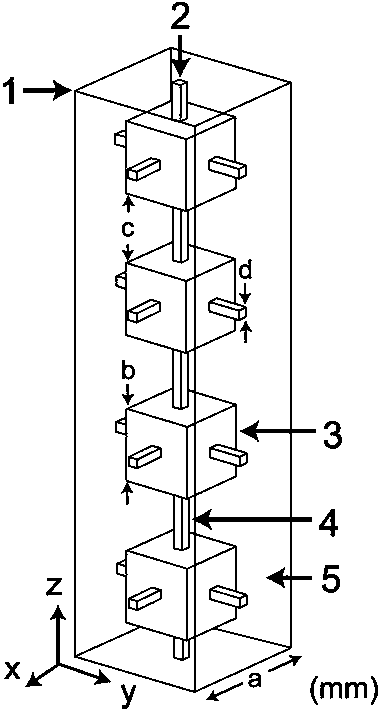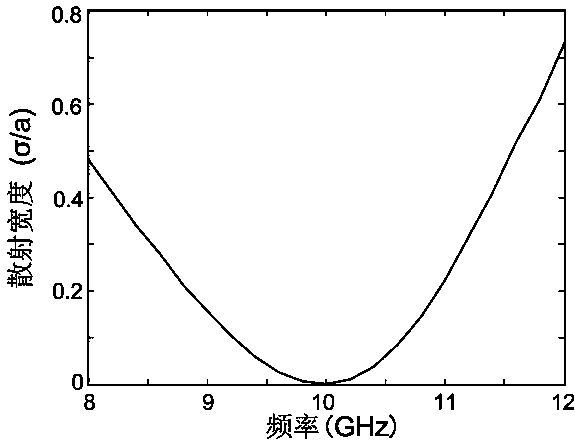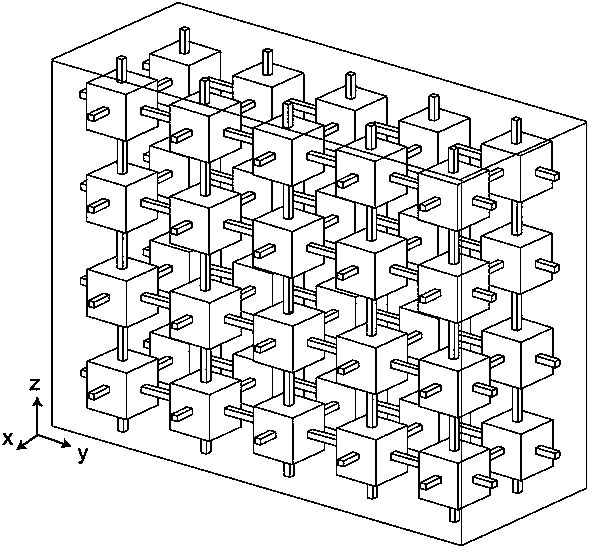Zero-scattering linear particle and electromagnetic invisible material formed by the same
A particle and ray technology, applied in the field of electromagnetic stealth materials, can solve the problems of large spatial dispersion of electromagnetic parameters and complex realization, and achieve the effects of small loss, convenient realization and high transmittance
- Summary
- Abstract
- Description
- Claims
- Application Information
AI Technical Summary
Problems solved by technology
Method used
Image
Examples
Embodiment 1
[0043] The size and composition medium of zero-scattering linear particle example 1 are as figure 1 shown. The axial cross-section of the zero-scattering linear particles in a square column structure is a square with side length a of 7mm, the metal structure is copper, and the electrical conductivity is 5.96×10 7 S / m, the arrangement period c of the metal unit is 7mm, the side length c of the cube metal particle is 4mm, the axial section side length d of the small square column type connecting column protruding from the six sides of the cube metal particle is 0.6mm, and the length is 1.5mm. The dielectric selected in this example is polysulfone (Polysulfone), with a relative permittivity of 2.97, a loss tangent of 0.0013, and a relative permeability of 1. The corresponding zero-scattering operating frequency is 10GHz. Simulation results such as figure 2As shown, at the working frequency, when the electromagnetic wave is perpendicularly incident, the scattering width of th...
Embodiment 2
[0047] The size and composition medium of zero-scattering linear particle example 2 are as Figure 4 shown. The axial cross-section of the zero-scattering linear particles in a square column structure is a square with side length a of 7mm, the metal structure is copper, and the electrical conductivity is 5.96×10 7 S / m, the arrangement period c of the spherical metal unit is 7mm, the radius is 2.5mm, and the diameter b is 5mm. The axial section of the cylindrical connecting column protruding from the three orthogonal directions of the spherical metal particles is a circle with a radius of 0.148mm , its diameter d is 0.296mm, and its length is 1mm. The dielectric selected in this example is still polysulfone (Polysulfone), and the corresponding zero-scattering working frequency is still 10 GHz. Simulation results such as Figure 5 As shown, at the working frequency, when the electromagnetic wave is perpendicularly incident, the scattering width of the zero-scattering linear p...
PUM
| Property | Measurement | Unit |
|---|---|---|
| electrical conductivity | aaaaa | aaaaa |
| relative permittivity | aaaaa | aaaaa |
| dielectric loss | aaaaa | aaaaa |
Abstract
Description
Claims
Application Information
 Login to View More
Login to View More - R&D
- Intellectual Property
- Life Sciences
- Materials
- Tech Scout
- Unparalleled Data Quality
- Higher Quality Content
- 60% Fewer Hallucinations
Browse by: Latest US Patents, China's latest patents, Technical Efficacy Thesaurus, Application Domain, Technology Topic, Popular Technical Reports.
© 2025 PatSnap. All rights reserved.Legal|Privacy policy|Modern Slavery Act Transparency Statement|Sitemap|About US| Contact US: help@patsnap.com



